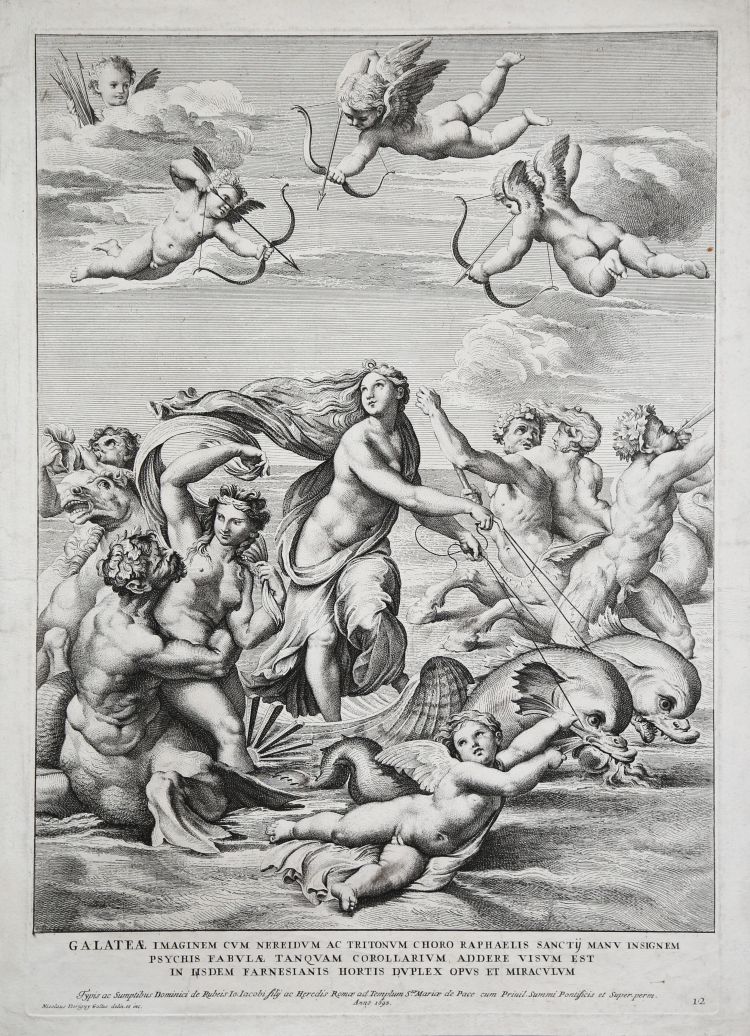



| Reference: | S45378 |
| Author | Nicolas DORIGNY |
| Year: | 1693 |
| Measures: | 360 x 520 mm |


| Reference: | S45378 |
| Author | Nicolas DORIGNY |
| Year: | 1693 |
| Measures: | 360 x 520 mm |
The triumph of Galatea, after Raphael, with Galatea standing on a half-shell, led by two dolphins and surrounded by nereids and tritons.
Numbered on plate; lettered at lower centre: 'GALATEAE IMAGINEM CUM NEREIDUM AC TRITONUM CHORO RAPHAELIS SANCTII MANU INSIGNEM / PSYCHIS FABULAE TANQUAM COROLLARIUM ADDERE VISUM EST / IN IISDEM FARNESIANIS HORTIS DUPLEX OPUS ET MIRACULUM / Typis ac Sumptibus Dominici de Rubeis Io. Iacobi filii ac Heredis Romae ad Templum Stae. Mariae de Pace cum Privil. Summi Pontificis, et Super. perm. / Anno 1693.'; at lower left: 'Nicolaus Dorigny Gallus delin. et. inc.'.
Dorigny's engraved print is part of a major publishing venture aimed at illustrating Raphael's frescoes in the Loggia della Farnesina. The series published in 1693 for the types of Domenico di Giovanni Giacomo de Rossi, a Roman publisher who kept his workshop at the church of Santa Maria della Pace, consists of 11 etched plates taken from the scenes in the Loggia, while the last one reproduces the Galatea from the adjoining room. The prints, provided with papal privilege, are preceded by a frontispiece with the title and dedication to the Duke of Parma Ranuccio II Farnese, whose heraldic arms appear in the lower left corner. All engravings are numbered and bear explanatory inscriptions in the lower margin in Latin taken from the fable of Cupid and Psyche, described by Apuleius in Asino d'Oro. The choice of commentary texts is due to Giovan Pietro Bellori, the erudite classicist and trusted intellectual of the Farnese’s Family. The copperplates for the series were destroyed in the early 19th century by order of pope Leone XII (Le Blanc).
Etching with engraving, a fine impression, printed on contemporary laid paper, with margins, very good condition.
Bibliografia
IFF / Inventaire du Fonds Français: Bibliothèque Nationale, Département des Estampes (31).
Nicolas DORIGNY (Parigi 1652 - 1746)
|
Son of Michel Dorigny. He trained with his father but abandoned painting for engraving early in his career. In 1687 he went to Rome, summoned by his brother Louis Dorigny, producing there a series of reproductions of antique statues, published by Rossi in 1704. From Rome he went to London, where he worked for the British royal family. Between 1711 and 1719 he engraved Raphael’s cartoons of the Acts of the Apostles (London, V&A), for which he was knighted by George I in 1720. He returned to France suffering from eye trouble and was received (reçu) as a member of the Académie Royale in 1725. He exhibited at the Salons of 1739 and 1743. He made more than 140 prints, combining etching and engraving in an expansive, vigorous style close to that of Gérard Audran. Besides portraits, his works are mostly reproductive prints after the Italian masters, particularly Raphael, Carlo Maratti, Domenichino, Guercino and Giovanni Lanfranco. The Nationalmuseum, Stockholm, has a number of his drawings commissioned by Count Tessin, including Roman sculptures, coats of arms and catafalques.
|
Nicolas DORIGNY (Parigi 1652 - 1746)
|
Son of Michel Dorigny. He trained with his father but abandoned painting for engraving early in his career. In 1687 he went to Rome, summoned by his brother Louis Dorigny, producing there a series of reproductions of antique statues, published by Rossi in 1704. From Rome he went to London, where he worked for the British royal family. Between 1711 and 1719 he engraved Raphael’s cartoons of the Acts of the Apostles (London, V&A), for which he was knighted by George I in 1720. He returned to France suffering from eye trouble and was received (reçu) as a member of the Académie Royale in 1725. He exhibited at the Salons of 1739 and 1743. He made more than 140 prints, combining etching and engraving in an expansive, vigorous style close to that of Gérard Audran. Besides portraits, his works are mostly reproductive prints after the Italian masters, particularly Raphael, Carlo Maratti, Domenichino, Guercino and Giovanni Lanfranco. The Nationalmuseum, Stockholm, has a number of his drawings commissioned by Count Tessin, including Roman sculptures, coats of arms and catafalques.
|